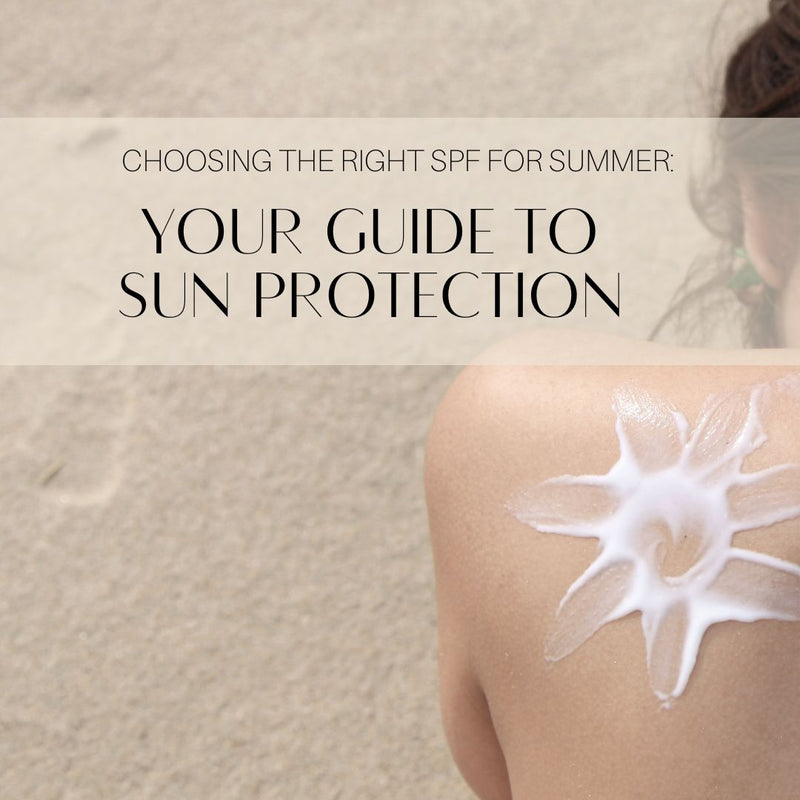Choosing the Right SPF for Summer: Your Guide to Sun Protection

As summer approaches and the sun's rays become more intense, selecting the right SPF (Sun Protection Factor) becomes crucial for safeguarding your skin against harmful UV damage. With a plethora of options available, navigating the sunscreen aisle can be overwhelming. Fear not! Here's a concise guide to help you choose the correct SPF for a sun-safe summer:
Understand SPF Ratings
SPF measures a sunscreen's ability to protect your skin from UVB rays, which are primarily responsible for causing sunburns. The higher the SPF, the greater the protection. Here's a breakdown of SPF ratings:
- SPF 15: Provides moderate protection against UVB rays. Suitable for daily wear, especially during brief sun exposure.
- SPF 30: Offers high protection and is recommended for extended outdoor activities. Ideal for everyday use, particularly for those with fair to medium skin tones.
- SPF 50: Provides very high protection and is suitable for prolonged sun exposure, outdoor sports, or vacations in sunny destinations.
- SPF 50+: Offers the highest level of protection available and is recommended for individuals with sensitive skin or a history of skin cancer.
Consider Your Skin Type and Activities
When choosing an SPF for summer, consider your skin type, lifestyle, and planned activities:
- Skin Type: Individuals with fair or sensitive skin may benefit from higher SPF formulations to prevent sunburns and minimize the risk of sun damage. Those with darker skin tones should still use SPF to protect against UV damage and premature aging.
- Outdoor Activities: If you'll be spending extended periods outdoors, participating in water sports, or sweating profusely, opt for water-resistant or sport-specific sunscreens with higher SPF levels to ensure lasting protection.
Mineral vs Chemical
Mineral Sunscreen
Mineral sunscreens, also known as physical or inorganic sunscreens, contain active mineral ingredients such as zinc oxide and titanium dioxide. These minerals work by sitting on the skin's surface and creating a physical barrier that reflects and scatters UV rays away from the skin.
Pros:
- Broad-Spectrum Protection: Mineral sunscreens offer broad-spectrum protection against both UVA and UVB rays, making them effective at preventing sunburns, premature aging, and skin cancer.
- Gentle on Skin: Ideal for sensitive skin types, mineral sunscreens are less likely to cause irritation or allergic reactions compared to their chemical counterparts.
- Immediate Protection: Mineral sunscreens provide protection as soon as they are applied, making them suitable for individuals who need instant sun protection.
Cons:
- White Cast: Some mineral sunscreens may leave a white or chalky residue on the skin due to the reflective nature of zinc oxide and titanium dioxide.
- Thicker Texture: Mineral sunscreens tend to have a thicker consistency, which can feel heavy or greasy on the skin, especially in humid climates.
Chemical Sunscreen
Chemical sunscreens, also referred to as organic sunscreens, contain active chemical ingredients such as avobenzone, octinoxate, and oxybenzone. These chemicals work by absorbing UV rays and converting them into heat, which is then released from the skin.
Pros:
- Lightweight Formulation: Chemical sunscreens typically have a lighter texture and blend seamlessly into the skin, making them suitable for daily wear under makeup or during outdoor activities.
- No White Residue: Unlike mineral sunscreens, chemical sunscreens do not leave a white cast on the skin, providing a more aesthetically pleasing finish.
- Ease of Application: Chemical sunscreens are easier to apply and spread evenly on the skin, requiring less effort for thorough coverage.
Cons:
- Potential Irritation: Some individuals with sensitive skin may experience irritation or allergic reactions to certain chemical sunscreen ingredients, such as oxybenzone or octocrylene.
- Absorption Time: Chemical sunscreens need to be absorbed into the skin before they become effective, so it's recommended to wait approximately 15-20 minutes after application before sun exposure.
- Limited Broad-Spectrum Protection: While many chemical sunscreens offer broad-spectrum protection, some ingredients may degrade over time when exposed to sunlight, reducing their effectiveness against UVA rays.
Check for Broad-Spectrum Protection
Ensure that the sunscreen offers broad-spectrum protection, which shields your skin from both UVA and UVB rays. UVA rays penetrate deeply into the skin, leading to premature aging and an increased risk of skin cancer, while UVB rays primarily cause sunburns. Look for labels that mention "broad-spectrum" to ensure comprehensive sun protection.
Apply Adequate Amount and Reapply Regularly
Regardless of the SPF level, proper application and reapplication are key to effective sun protection. Apply a generous amount of sunscreen (about one ounce) to cover all exposed areas of your skin at least 15 minutes before sun exposure. Reapply every two hours, or immediately after swimming, sweating, or towel-drying, to maintain continuous protection throughout the day.
Conclusion
Choosing the correct SPF for summer is essential for safeguarding your skin against UV damage and reducing the risk of sunburns, premature aging, and skin cancer. By understanding SPF ratings, considering your skin type and activities, checking for broad-spectrum protection, and practicing proper application and reapplication, you can enjoy a sun-safe summer with peace of mind and radiant skin.